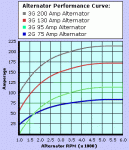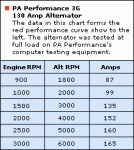The size of the alternator won't help that is a function of load on the engine caused by a sudden electrical demand on the alternator. The more that is required of the alternator the harder it is to turn it over. The problem is that the larger the electrical load the more HP it takes to operate the alternator and your engine has a limited number of horses and at idle it is producing very few of them. I don't have any numbers about HP requirements based on load, but it definitely is noticeable when that fan kicks in. I don't think anyone has done any dynamometer tests to see what the actual losses are based on electrical load, though that would be interesting, to me anyway

/emoticons/
[email protected] 2x" width="20" height="20" /> . It only takes about a second or two and the fan is back to it's running 33 Amps and is only noticeable when at idle. The kicker pushes the RPMs up from 650 to 850 and that is enough to keep the engine from stalling, but without it the engine almost dies, in fact it probably would if I were not quick on the peddle.
I subscribe to Ford Muscle Magazine
http://www.fordmuscle.com , there are a lot of articles you may find interesting and helpful in what you are doing.

>-


